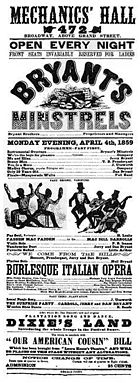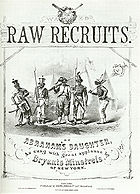
Bryant's Minstrels
Encyclopedia

Blackface
Blackface is a form of theatrical makeup used in minstrel shows, and later vaudeville, in which performers create a stereotyped caricature of a black person. The practice gained popularity during the 19th century and contributed to the proliferation of stereotypes such as the "happy-go-lucky darky...
minstrel
Minstrel show
The minstrel show, or minstrelsy, was an American entertainment consisting of comic skits, variety acts, dancing, and music, performed by white people in blackface or, especially after the Civil War, black people in blackface....
troupe that performed in the mid-19th century, primarily in New York City
New York City
New York is the most populous city in the United States and the center of the New York Metropolitan Area, one of the most populous metropolitan areas in the world. New York exerts a significant impact upon global commerce, finance, media, art, fashion, research, technology, education, and...
. The troupe was led by the O'Neill brothers from upstate New York, who took the stage name Bryant.
The eldest brother Jerry, a veteran of the Ethiopian Serenaders, Campbell's Minstrels, E.P. Christy's Minstrels and other troupes, sang and played tambourine
Tambourine
The tambourine or marine is a musical instrument of the percussion family consisting of a frame, often of wood or plastic, with pairs of small metal jingles, called "zils". Classically the term tambourine denotes an instrument with a drumhead, though some variants may not have a head at all....
and bones
Bones (instrument)
The bones are a musical instrument which, at the simplest, consists of a pair of animal bones, or pieces of wood or a similar material. Sections of large rib bones and lower leg bones are the most commonly used true bones, although wooden sticks shaped like the earlier true bones are now more...
. Dan Bryant, who had toured with Losee's Minstrels, the Sable Harmonists and Campbell's Minstrels, sang and played banjo
Banjo
In the 1830s Sweeney became the first white man to play the banjo on stage. His version of the instrument replaced the gourd with a drum-like sound box and included four full-length strings alongside a short fifth-string. There is no proof, however, that Sweeney invented either innovation. This new...
. Neil (Cornelius) Bryant played accordion
Accordion
The accordion is a box-shaped musical instrument of the bellows-driven free-reed aerophone family, sometimes referred to as a squeezebox. A person who plays the accordion is called an accordionist....
and flutina
Flutina
The flutina is an early precursor to the diatonic button accordion, having one or two rows of treble buttons, which are configured to have the tonic of the scale, on the "draw" of the bellows. There is usually no bass keyboard: the left hand operates an air valve . A rocker switch, called a...
. Other members, including English-born fiddler Phil Isaacs, rounded out the original roster. All of the minstrels danced and acted in comedy segments, which were often improvised.
Bryant's Minstrels first performed on 23 February 1857 at Mechanics' Hall
Mechanics' Hall, New York City
For other buildings called Mechanics Hall, see Mechanics Hall.Mechanics' Hall was a meeting hall and theatre seating 2,500 people located at 472 Broadway in New York City, United States. It had a brown façade...
on Broadway
Broadway (New York City)
Broadway is a prominent avenue in New York City, United States, which runs through the full length of the borough of Manhattan and continues northward through the Bronx borough before terminating in Westchester County, New York. It is the oldest north–south main thoroughfare in the city, dating to...
. The Bryants each brought with them the acts and songs they had learned and perfected while playing in other troupes. These older, proven pieces created a nostalgic format of primarily plantation
Plantation
A plantation is a long artificially established forest, farm or estate, where crops are grown for sale, often in distant markets rather than for local on-site consumption...
-themed material that seemed to ignore contemporary discussion over abolition
Abolitionism
Abolitionism is a movement to end slavery.In western Europe and the Americas abolitionism was a movement to end the slave trade and set slaves free. At the behest of Dominican priest Bartolomé de las Casas who was shocked at the treatment of natives in the New World, Spain enacted the first...
. Songs on the bill included Stephen Foster's
Stephen Foster
Stephen Collins Foster , known as the "father of American music", was the pre-eminent songwriter in the United States of the 19th century...
"Gentle Annie
Gentle Annie (song)
"Gentle Annie" is a popular American song composed by Stephen Foster in 1856. The song has original lyrics but is said to be based on a traditional Irish melody. According to his niece, Evelyn Foster Morneweck, there is a tradition that it was written in honor of Annie Jenkins, the daughter of a...
" and the Christy Minstrels' "See, Sir, See" and "Down in Alabama".
The Bryants proved a hit with audiences and critics alike. One reviewer wrote that "it is gratifying to find that we have yet among us those who will not suffer the original type of negro eccentricity to die out altogether. The connecting link . . . are [sic] the Bryant's Minstrels . . . and it is therefore to be hoped for that they will continue as they have begun, and stick to the 'old style' entertainment." Over the next few months, they became one of New York's more popular acts. The Clipper
New York Clipper
The New York Clipper, also known as The Clipper, was a weekly entertainment newspaper published in New York City from 1853 to 1924. It covered many topics, including circuses, dance, music, the outdoors, sports, and theatre. It had a circulation of about 25,000. The publishers also produced the...
wrote on 20 June that "The different bands of Minstrels, in this city, have experienced a wonderful falling off in patronage since the advent among us of the 'Bryants.'" Another review spoke of "a combination of comical talent . . . never before witnessed in Ethiopian Minstrelsy . . . ." Even a nationwide economic downturn in 1858 did not hurt their revenues. The Mechanics' Hall remained their primary venue until May 1866.
Over the troupe's life, members came and went. In October or November 1858, Dan Emmett
Dan Emmett
Daniel Decatur "Dan" Emmett was an American songwriter and entertainer, founder of the first troupe of the blackface minstrel tradition.-Biography:...
joined as primary songwriter
Songwriter
A songwriter is an individual who writes both the lyrics and music to a song. Someone who solely writes lyrics may be called a lyricist, and someone who only writes music may be called a composer...
for what would prove the most prolific period of his career. He also performed fiddle
Fiddle
The term fiddle may refer to any bowed string musical instrument, most often the violin. It is also a colloquial term for the instrument used by players in all genres, including classical music...
, banjo, drum, fife, and vocals. The song "Dixie
Dixie (song)
Countless lyrical variants of "Dixie" exist, but the version attributed to Dan Emmett and its variations are the most popular. Emmett's lyrics as they were originally intended reflect the mood of the United States in the late 1850s toward growing abolitionist sentiment. The song presented the point...
", usually attributed to him, was first performed on stage by the Bryants during an 1859 concert. The final act of most minstrel shows of the time were blackface burlesque
American burlesque
American Burlesque is a genre of variety show. Derived from elements of Victorian burlesque, music hall and minstrel shows, burlesque shows in America became popular in the 1860s and evolved to feature ribald comedy and female striptease...
s of mainstream theater, but "Dixie" and songs like it prompted an industry-wide revival of plantation
Plantation
A plantation is a long artificially established forest, farm or estate, where crops are grown for sale, often in distant markets rather than for local on-site consumption...
-related material. Emmett's songs proliferated among rival companies. Emmett's influence also helped mature the walkaround
Walkaround
A walkaround was a dance from the blackface minstrel shows of the 19th century. The walkaround began in the 1840s as a dance for one performer, but by the 1850s, many dancers or the entire troupe participated...
from a simple dance to a complete song-and-dance routine.

Christy's Minstrels
Christy's Minstrels, sometimes referred to as the Christy Minstrels, were a blackface group formed by Edwin Pearce Christy, a well-known ballad singer, in 1843, in Buffalo, New York. They were instrumental in the solidification of the minstrel show into a fixed three-act form...
, the Bryants were the longest-lasting minstrel troupe to have formed before the Civil War. Jerry Bryant died in 1861, but during the war, Bryant's Minstrels carried on, populating their shows with pro-Union
Union (American Civil War)
During the American Civil War, the Union was a name used to refer to the federal government of the United States, which was supported by the twenty free states and five border slave states. It was opposed by 11 southern slave states that had declared a secession to join together to form the...
songs such as "One Country and One Flag" and "Raw Recruits," as well as Irish characterizations and songs such as "Finigan's Wake" and "Lanigan's Ball".
Dan Emmett left the troupe in July 1866, although he occasionally composed music for the Bryant's even after his departure. Mechanics' Hall burned that same year and Bryant's Minstrels left New York for a road trip to San Francisco. On their return to New York in 1868, they took over the theater in Tammany Hall
Tammany Hall
Tammany Hall, also known as the Society of St. Tammany, the Sons of St. Tammany, or the Columbian Order, was a New York political organization founded in 1786 and incorporated on May 12, 1789 as the Tammany Society...
on East 14th Street and later moved into their own "Opera House" on 23rd Street.
The late 1860s and 1870s saw minstrel production grow increasingly elaborate and expensive and troupe sizes enlarge. The Bryants stuck with their traditional formula and their popularity waned as a result. Adding the African American dwarf Thomas Dilward
Thomas Dilward
Thomas Dilward , also known by the stage name Japanese Tommy, was an African American dwarf who performed in the blackface minstrel show.-References:...
to their ranks in the late 1860s (under the stage name
Stage name
A stage name, also called a showbiz name or screen name, is a pseudonym used by performers and entertainers such as actors, wrestlers, comedians, and musicians.-Motivation to use a stage name:...
"Japanese Tommy") did little to stem the tide.
Dan Bryant died in his New York City home in 1875, but the troupe carried on for seven more years under the management of his surviving brother Neil.

